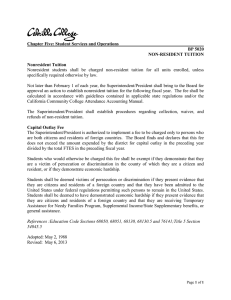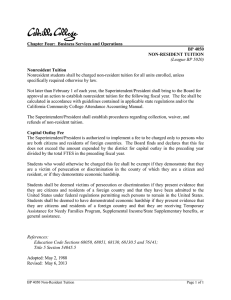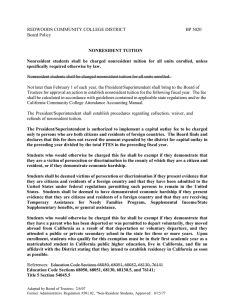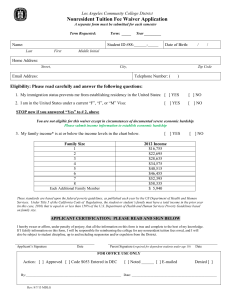CALIFORNIA COMMUNITY COLLEGES CHANCELLOR’S OFFICE To:
advertisement
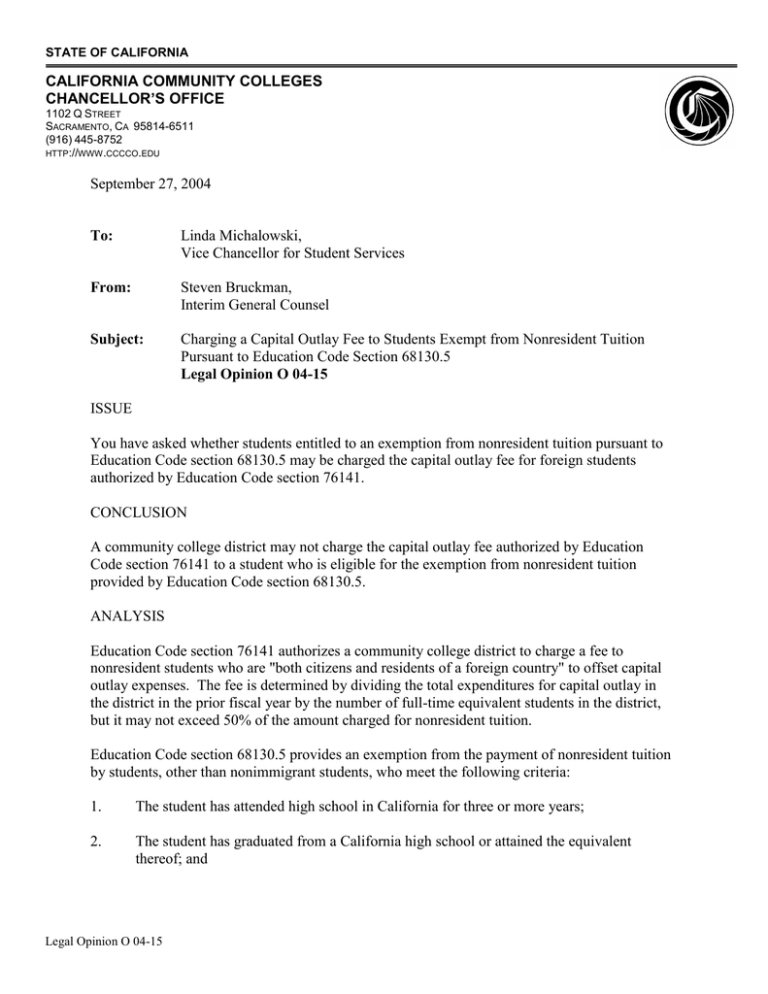
STATE OF CALIFORNIA CALIFORNIA COMMUNITY COLLEGES CHANCELLOR’S OFFICE 1102 Q STREET SACRAMENTO, CA 95814-6511 (916) 445-8752 HTTP://WWW .CCCCO.EDU September 27, 2004 To: Linda Michalowski, Vice Chancellor for Student Services From: Steven Bruckman, Interim General Counsel Subject: Charging a Capital Outlay Fee to Students Exempt from Nonresident Tuition Pursuant to Education Code Section 68130.5 Legal Opinion O 04-15 ISSUE You have asked whether students entitled to an exemption from nonresident tuition pursuant to Education Code section 68130.5 may be charged the capital outlay fee for foreign students authorized by Education Code section 76141. CONCLUSION A community college district may not charge the capital outlay fee authorized by Education Code section 76141 to a student who is eligible for the exemption from nonresident tuition provided by Education Code section 68130.5. ANALYSIS Education Code section 76141 authorizes a community college district to charge a fee to nonresident students who are "both citizens and residents of a foreign country" to offset capital outlay expenses. The fee is determined by dividing the total expenditures for capital outlay in the district in the prior fiscal year by the number of full-time equivalent students in the district, but it may not exceed 50% of the amount charged for nonresident tuition. Education Code section 68130.5 provides an exemption from the payment of nonresident tuition by students, other than nonimmigrant students, who meet the following criteria: 1. The student has attended high school in California for three or more years; 2. The student has graduated from a California high school or attained the equivalent thereof; and Legal Opinion O 04-15 Linda Michalowski 3. 2 September 27, 2004 In the case of a person without lawful immigration status, the person has filed an affidavit with the institution of higher education stating that the student has filed an application to legalize his or her immigration status, or will file an application as soon as he or she is eligible to do so. Section 68130.5 exempts those students who meet its criteria from payment of nonresident tuition, but it does not provide a direct exemption from the separate capital outlay fee authorized by section 76141. However, we consider here the possibility that the group of students who qualify for the exemption provided by section 68130.5 is defined in a manner which ensures that they would not be subject to the capital outlay fee because they are not "both citizens and residents of a foreign country" within the meaning of section 76141. Clearly, many of the students who qualify for the exemption provided by section 68130.5 would not be subject to payment of the capital outlay fee because they are citizens of the United States or foreign citizens who have immigrated or otherwise lawfully established residence in California or elsewhere in the U.S. This leaves at issue those individuals who do not have lawful immigration status but who do satisfy the requirements of section 68130.5. We think the question of whether these students should be subject to the capital outlay fee can best be answered by reviewing the legislative intent underlying the two statutes. Section 76141 was added to the Education Code in 1991 by Assembly Bill 2055 (Stats. 1991, ch. 853). During the course of the Legislature’s consideration of AB 2055, legislators were repeatedly advised that the bill was intended to apply to wealthy foreign students who come here for college, return to their countries of origin, and do not pay taxes to help support capital outlay projects at the colleges they attend. For example, the Republican staff analysis prepared for the April 22, 1991, hearing on AB 2055 by the Assembly Committee on Higher Education, notes that foreign F-1 Visa students "attend popular coastal CCs for a limited time and return to their native land." The analysis goes on to point out that, "These students pay no taxes" and that, "Most foreign students are wealthy and would not be deterred from attending." By contrast, it appears that section 68130.5 was intended to benefit a quite different population. As noted above, section 68130.5 requires "high school attendance for three or more years" in California in addition to other requirements and the legislative history confirms that this was intended to ensure that students have resided in California for a long period of time. Section 68130.5 was added to the Education Code by Assembly Bill 540 (Stats. 2001, ch. 814). The bill summary prepared for the hearing by the Senate Committee on Education on June 20, 2001, verifies that the benefits were intended for "long-term California residents." The analysis also refers to similar legislation in Texas "allowing long-term immigrants to pay in-state tuition." This analysis then goes on to note that students who are "long term California high school students" and their families "pay taxes and invest in the system; therefore, should they not, in return, receive benefits?" The comments to the concurrence in Senate amendments (as amended September 7, 2001) also include the following: "According to the author, many of the students that would benefit under this measure are children of parents who have been granted amnesty by the federal government Legal Opinion O 04-15 Linda Michalowski 3 September 27, 2004 and are waiting for their own applications for citizenship to be accepted by the Immigration and Naturalization Service. The majority of these students consider California their home and are expected to become citizens." The uncodified portion of AB 540 also verifies the intent that the provisions benefit persons who have long-term presence in California: "The Legislature hereby finds and declares all of the following: [¶] (1) There are high school pupils who have attended elementary and secondary schools in this state for most of their lives and who are likely to remain . . . ." (Stats. 2001, ch. 814, § 1(a)(1).) Thus, the legislative history of AB 540 confirms that the persons who are eligible for the exemption from nonresident tuition are persons who have a long-term presence in California and who have contributed to California’s economy. In principle, this means they have already contributed to public funds that are used for capital expenses. The legislative history of AB 2055 suggests that the Legislature did not intend to authorize community college districts to charge an additional capital outlay fee to such students. Accordingly, we conclude that a community college district may not charge a capital outlay fee pursuant to section 76141 to students who qualify for the exemption from nonresident tuition described in section 68130.5. SB:RB:sj O 04-15 Legal Opinion O 04-15
